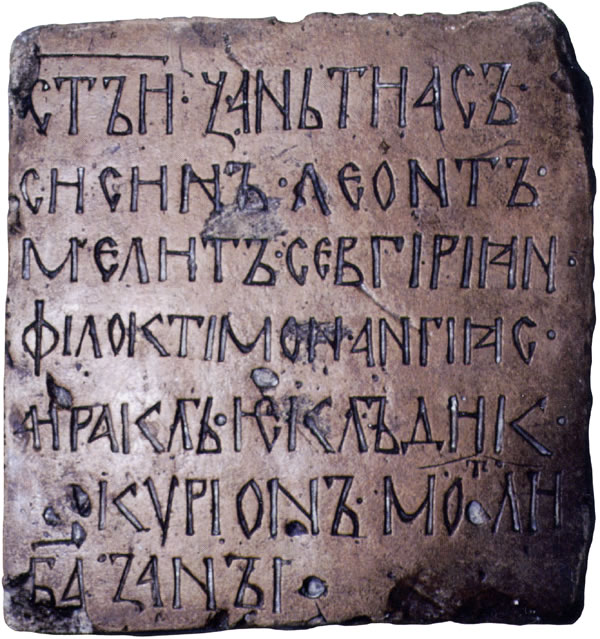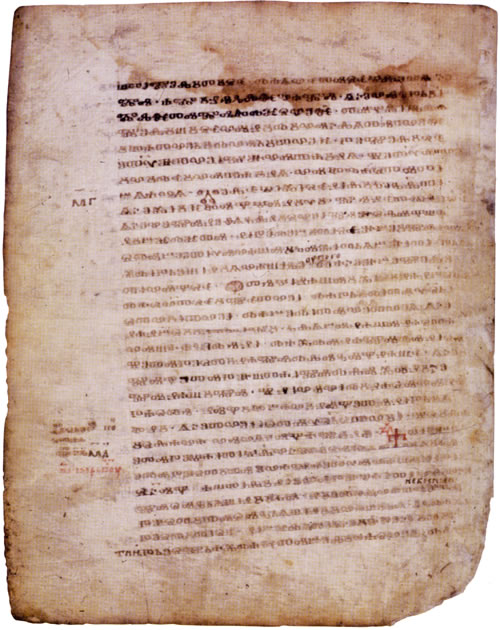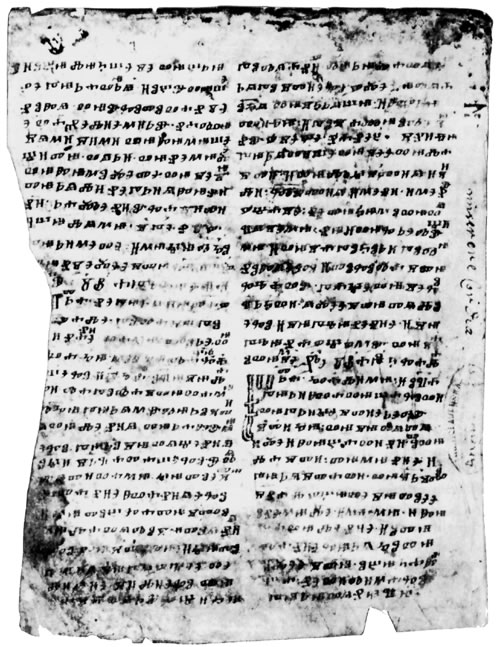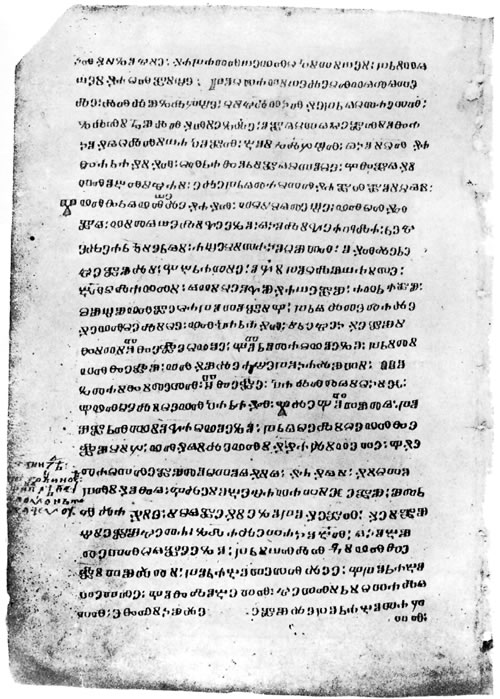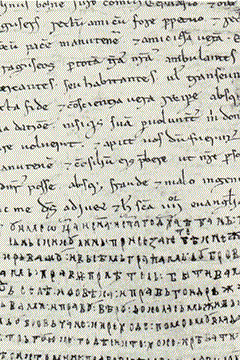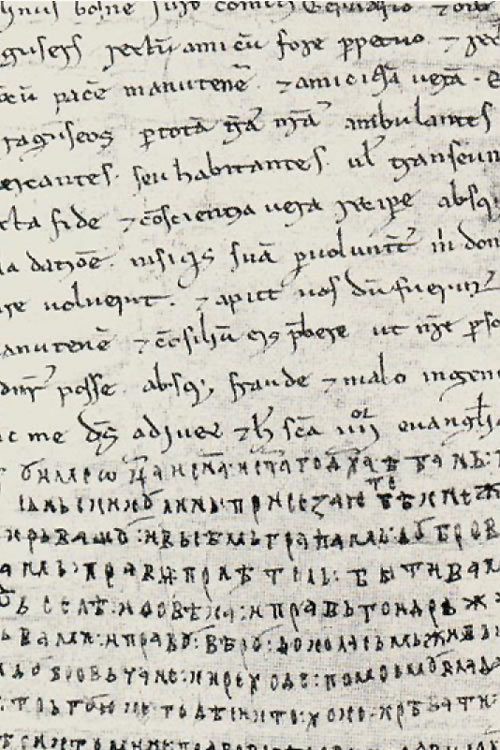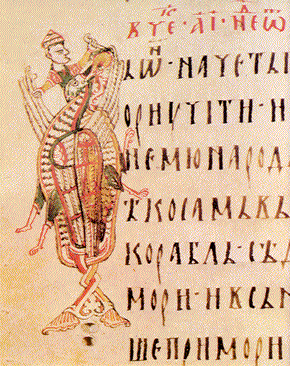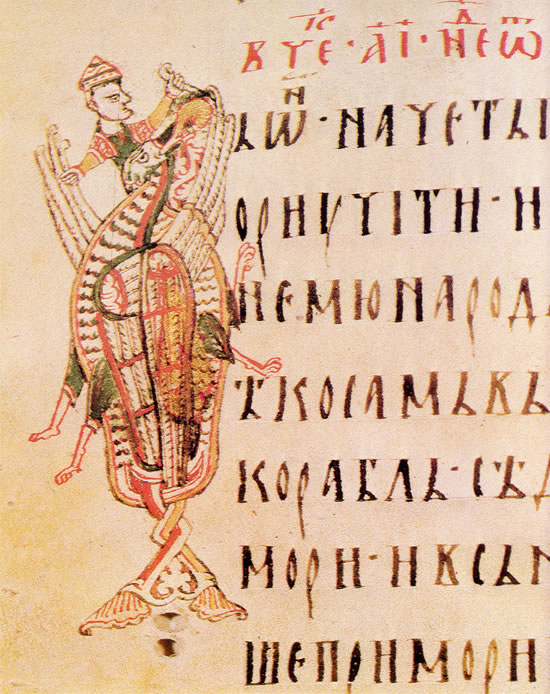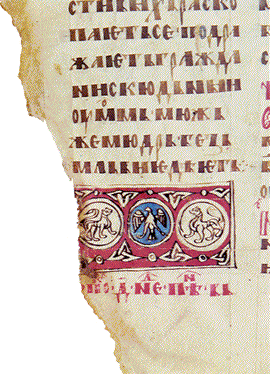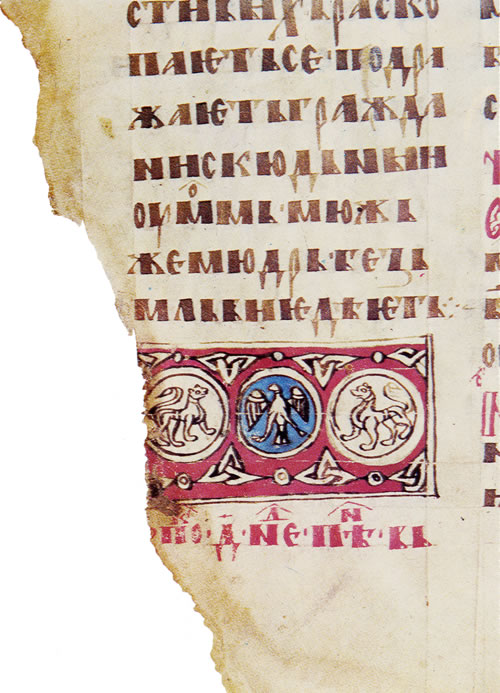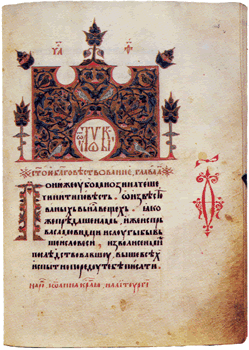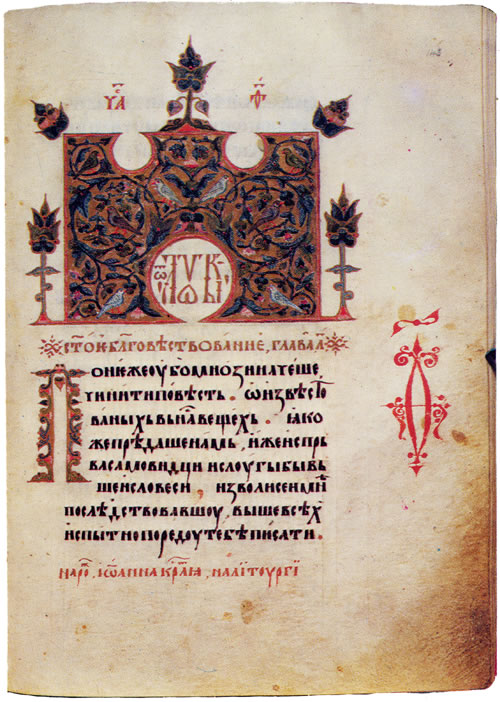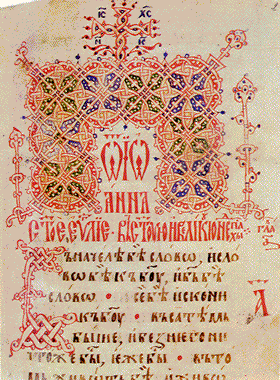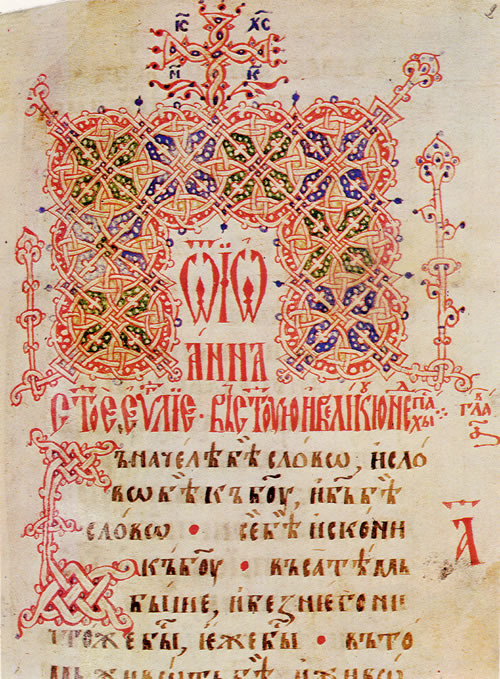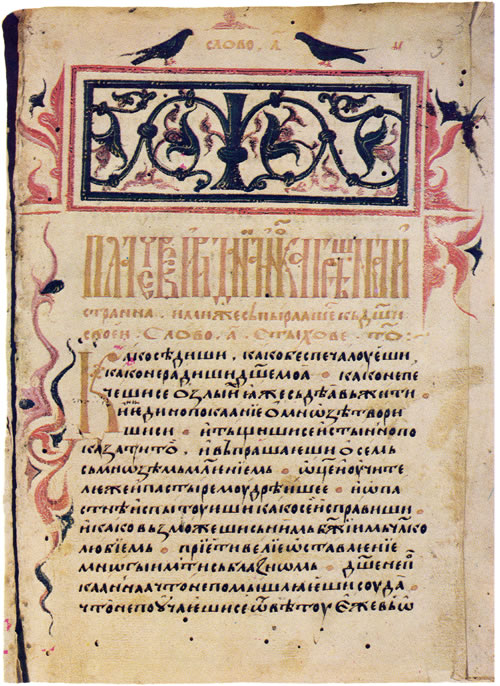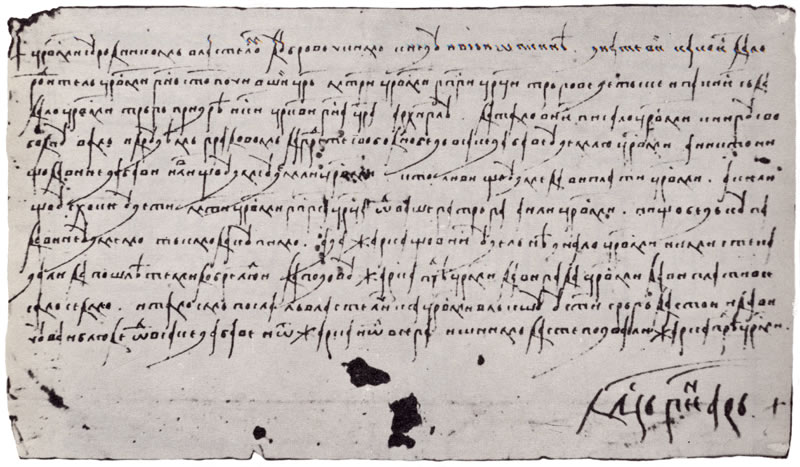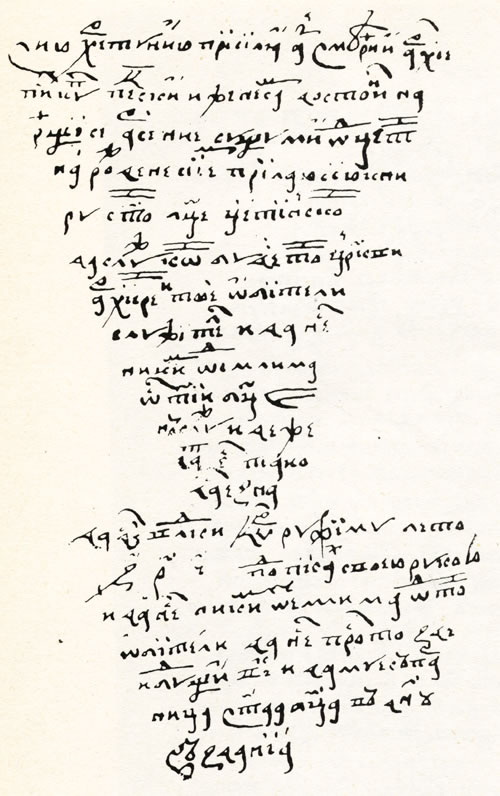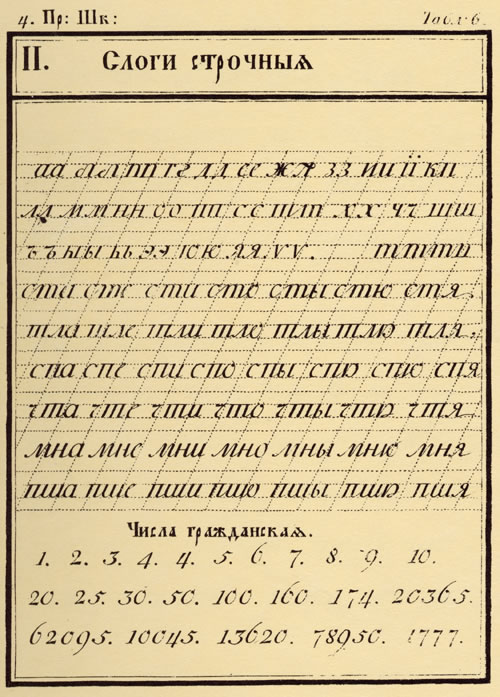FROM SAINT CYRIL TO ORFELIN
autor: Stjepan Fileki
translation into English: Vesna Janković
Today it can be determined with quite precision the time when the first Slavic script was designed. However what we do not know and what remains historical secret is the question – who, in fact, is its author? It has bee widely accepted that the authors were Saint Cyril and Saint Methodius but there is no enough evidence for such assertation. Still they deserved enormous credit for what they did. For sure they are the founders of the Slavonic literacy, they introduced people's language in liturgy and it is certain that they created the first Slavic script – Glagolitic.
The Slavic brothers or the brothers educators, as they are also called, are the Greeks born in Thessaloniki. The younger brother, Saint Cyril was, from his early youth, interested in the problems of language and script. After completing education he became a priest and then a teacher in the imperial Magnaur School in Constantinople in which he later acquired the title of philosopher. Together with his brother Methodius he went to various missions in Khasaria an area between the Don and Caucaus. There Cyril learned Jewish and Samaritian languages and scripts and widen his philological education. Upon their return to Constantinople the brothers faced new mission. The Byzantine Emperor Michael, based on the request of the Moravian Prince Rastislav sent them to Moravia to preach in Slavonic language i.e., as Prince was writing in his request to the Byzantine Emperor “…who will preach the real Christian fate in our own language...” The Thessaloniki brothers who spoke pure Slavonic language prepared in Constantinople everything they would need for successful accomplishment of the job entrusted to them. Together with their assistants they translated Gospel into Slavic language and for that occasion Cyril made new script – the first Slavonic script.
After through preparations, together with several of their students they headed to Moravia to start supressing the increasing spiritual influence of the German priests, as Rastislav prayed for. Till that time both liturgy and church literature in Moravia were in Latin language. But soon it became obvious that a greater number of Slavonic priests was needed to procede with successful supression of the German influence. With the purpose of solving that issue they set off on a journey. On that journey they stopped in Pannonia.
King Kocel of Pannonia realised the importance of the brothers educators and gave them fifty of his people to be taught Slavonic face. From Pannonia, on their journey to Rome they stopped in Venice. There the Pope's invitation to come to Rome waited for them. Upon their arrival to Rome they were welcome with great regard and ceremoniously. The Pope Adrian II received them blessing their work, liturgy in Slavonic language and Slavonic church books and with this the first Slavonic script.
After that Cyril withdrew to the monastery in which he died after several weeks (869) at the age of forty. The elder brother Methodius continued the educational work. In the meantime he became the first Slavonic archbishop. After the mission in Pannonia and Moravia he returned to Constantinople where he made an agreement with the Tsar Vasily and Constantinople Patriarch on introducing Slavonic language in the liturgy of the Balkan Slavs. Soon after Methodius' death (885) the students of the Slavonic brothers continued each his own way.
Some of them stayed in Moravia, some left for south, to Adriatic coast. The majority went to the Bulgarian Tsar Boris whose capital was in Belgrade. At the end of the 9 th century two centers of Slavonic literacy were established, in Macedonia – Ohrid and in Bulgaria – Preslava. From there the Slavonic literacy spread to the Serbian states and Adriatic coast.
In time of Cyril and Methodious two types of Greek letters were in use in Byzantine: the majuscule and minuscule. These two types of faces were considerably different: majuscule was monumental and strictly defined and miniscule more free and dynamic.
The Balkan Slavs who, up to that time wrote in Greek script which had 24 letters rejected new one which had more letters. According to Crnorisac Hrabar the new script had 38 letters. As to him, the first Slavonic script had letters made as to the Greek origin. Based of this historic interpretation and everything else we know about the origin of the first Slavonic script it is clear that the first forms of Slavonic letters were made as to the Greek pattern. Taking over Greek letters meant taking over their sound value as well. It is still open issue if a script so devised was Glagolitic or Cyrillic? Which of the two letters was older? Two facts speaks for themselves: the first Slavonic script was used in Moravia, and these manuscripts were written in Glagolitic. Besides, it is known that Glagolitic texts contain more archaisms.
GLAGOLITIC
Nowhere in any historic document it was explicitly stated which script was designed by Cyril and it is often thought, having in mind the name, that it was Cyrillic. But it is not as simple as that. We know that in Cyril's time the Greek script was used in Byzantine. One of the often mentioned historical sources is the well known treatise of Crnorisac Hrabar “On Letters”. The original was not preserved, but from the preserved transcripts which were deliberately shortened or even added to by scribes we can learn something. At the end of this teatise we can read: “If you ask Greek writers who made the letters and who translated the Bible or in which time, only rare among them know that. But if you ask Slavonic writers who made the letters or translated the Bible they all know that and say: Saint Constantin Philosopher, called Cyril, he made the letters and translated the Bible and Methodius, his brother, for those who have seen them are still alive… and in the year 6363 (i.e.863) from the creation of the world.” From this citation, which may be credible the most important thing is not clear: which Slavonic script was made first and who made it. If we suppose that Glagolitic was made by Cyril in the second half of the 9 th century that remains the most probable hypothesis, for there is no written document on it, and the oldest dated monuments are at least a hundred years older.
In the oldest manuscripts written in Glagolitic we found 36 letters identical in all manuscripts of that time. Apart from individual letters thare are diphthongs as well. Majority of Glagolitic letters were derived from the Greek minuscule, while some were taken from Jewish and Samaritian. As the Glagolitic letters are written separately like Jewish and Samaritian ones, as it is usually done with majuscule, it is clear that the designer of the Cyrillic (Cyril) carried out one of the most difficult endavours of transforming majuscule into minuscule. It is certain that the constructor of the first Slavonic script apart from borrowing Greek and other mentioned letters made some as to his own ideas. For, some letters do not resemble any other letters known by that time Slavs. These letters were introduced for Slavonic language sounds.
With defined Glagolitic and previously structured Slavonic literary language the script started developing acquiring soon particular characteristics related to the area in which it was written and which reflected local speech. The works originating in Macedonia are different from the ones made in Serbian area and the latter are different from those made in Croatian, Czech or Bulgarian states.
Finally formed Glagolitic had 38 letters which completely met all phonetic characteristics of old Slavonic language. While it was in use Glagolitic developed in two specific forms: the roundish or Bulgarian and the squarish i.e. Croatian. The roundish one was in use in the eastern parts of the Slavonic lands with the squarish being used in Moravia and at the Adriatic coast. With roundish Glagolitic we also distinguish a type of high, narrow Glagolitic script. In both forms the letters were written and carved carelessly, often arbitrarily without any graphic knowledge and estetic aim. However the Glagolitic script with its general outlook and great number of individual letters impress with its originality.
CYRILLIC
It is open issue how much the Cyrillic is younger then Glagolitic and whether it is second Slavonic letter. It is known for sure that the Cyrillic was made when in liturgy and literature the old Slavonic language was used with its Glagolitic alphabet in Simeon's Bulgaria. In Simeon's time Bulgaria underwent great cultural raise. The new script, Cyrillic, was more beautiful and suitable, it was adopted quickly for it was more suitable than complicated and hardly legible Glagolitic. The Cyrillic suppressed Glagolitic which, until recently, have been used for writing and printing in the northwest parts of the Balkan Peninsula. The origin of the first Cyrillic is not doubted for its Greek origin is obvious. Many letters were taken over without any change. It is not known when exactly the transformation in Cyrillic has started, but it is quite certain that it was done by some student of the brothers educators. Some think that it was done by one of the most capable younger students of Cyril and Methodius, later Episcope of Preslava, and that Kliment (Clement) and his brother Naum refused to work on it, because of which, as stated, they were expelled to the end of the state, to Ohrid area.
USTAV
Based on all we know it is possible to conclude for certain that Cyrillic was designed in Simeon's Bulgaria. With its appearance no discontinuance with the Greek roots occured which happened when Glagolitic appeared. That first form of Cyrilic was made on the basis of Greek Uncial. The script, most often of vertical characters (there are documents written in slant wise letters, but that is not cursive) was written with wide curtailed pen. The letters have defined construction and they are carefully shaped. The ratio between thin and thick stroke ranges from 1:3 to 1:5. The texts were written in continuo, the words were not separated. The space between the rows was large, larger than the row height. All named characteristics apply to the first Cyrillic and main book letter Ustav. Since it appeared in the 9 th century till the 18 th century that first Cyrillic manuscript face changed its form with time. From the 9 th to the 14 th century the letters were wide, majority had square proportions and a number of them had symmetric shape. From the 14 th century they became narrower and Ustav became a script of narrow letters which were in use till the 18 th century when its regular use ceased.
In the earliest manuscripts there were three different types of Ustav as to their shape: strongly proportioned, written in big, heavy letters, medium Ustav and Ustav written in small, minute letters.
The Ustav that developed between the 9 th and the 14 th century is called older Ustav. The one developing between 14 th and 18 th century is called later Ustav. In its development the Ustav, exposed to various influence, changed in such a manner that some letters appeared in a number of different forms. These changes were mostly influenced by Skoropis which began to develop in the 13 th century. It influenced visibly the graphic changes of Ustav letters shape. The changes occurred due to the fact that the scribes, often deliberately introduced Skoropis' forms. It was natural for they wrote using both scripts. The letters “a”, “v”, “d', “ž” , “z”, “č” and “t” specially underwent the changes. That most often occurred with letter “t” which as tripod appeared in all three scripts – Ustav, Skoropis and Semi Ustav. These changes are observed in both Bulgarian and Macedonian texts but they were not always the same letters. Apart from these changes there are variants which the scribes made deliberately and so letter “V” appeared in three different shapes.
MAJUSCULE CURSIVE
The second manuscript letter was Majuscule cursive designed for everyday needs, for making notes, signatures and letters. The letters are mildly slanted to the right and were written without previously drawn system. The stylistic characteristics are not steady and it can be said that majuscule cursive is free hand-written interpretation of Ustav.
SEMI USTAV
There was another book script, apart from majuscule cursive, that also originated from ustav – Semi Ustav. The differences between Ustav and Semi Ustav are the following: the letters do not keep strictly to the two-line system, serifs of some of them extend across the basic line. These serifs are slightly slanted which is reflection of our hand inclination and capability. All these differences are caused by the need to write faster. Rounded parts of the letters are often transformed into square forms and some letters are mutually connected. Emphasised serifs make this script legible, and Semi Ustav became office script as well. Its development was obviously influenced by the material on which it was written and that was paper, which was much cheaper than parchment used up to that time. The new material with its characteristic made the differences between thick and thin strokes less visible which gave the latters new form thus distinguishing it from its model – Ustav. The letters became simpler, many details were simplified, and many letters got completely new shape. For example, letter “t” which had two expressive vertical serifs in Ustav on the left and right end of upper horizontal stroke changed its shape by replacing these serifs with two vertical strokes identical to the basic one. Such change produced interesting shape of “tripode” letter “t”. Several letters “d”, “r”, “u”, “h”, “c” and “ šta ” got lower serifs and letter “f' is stretched in all three fields of the system.
In the development of Semi Ustav we may observe its three types. In the first stage of its development in the 14 th and the 15 th centuries, Semi Ustav had a lot in common with its model – Ustav. This shape is called old (early) Semi Ustav. From the 15 th to the 18 th century a more unconfined shape was developed – late Semi Ustav.
In the third stage with increasingly free writing a form was created which was transition towards Skoropis. Eventually, with the introduction of the Russian civil script Semi Ustav ceased to be used. However, both Semi Ustav and Ustav continued to be used in the Orthodox liturgical literature.
SKOROPIS
Skoropis is the script that has all the characteristics of the individualized letter-shapes and personal stamp of its performer. It appeared early in history, almost at the same time as Ustav. In fact it is a kind of interpretation of Ustav. It is a cursive script, and as pointed out by its name it was designed for quick, economic writing. It was used as office face, for making notes and for correspondence. The texts from the books written in other scripts were coppied in it and though rearly, even the whole books were written in it.
It is in many ways different from Ustav. The rows were done in minute letters, letters' serifs are considerably longer, spaces between rows are large – two and more times bigger than the row height. Although Skoropis understood freedom in writing it still had defined shapes of the individual letters. At the end of the 17 th and beginning of the 18 th century the minuscule elements began to appear leading to the appearance of a new hand-written shape.
In that time our language and script were strongly influenced by the Russian language and script. Peter the Great script reform introduced Civil Cyrillic in Russia which was interpretation of contemporary Latin script. Gradually, Skoropis began to withdraw before the civil cursive which became obligatory letter taught in schools by the Russian teachers. That new letter was, same as Civil Cyrillic interpretation of the Latin, in this case of the English script and French coule – office face.
In our literacy these changes occurred in the first half of the 18 century. Our best known calligrapher of that time Zaharije Stefanović Orfelin, a writer and talented engraver, made a manuel for teaching manuscripts' writing. In his book The New and Basic Slavonic-Serbian (…) caligraphy, published in 1759 in Sremski Karlovci, Orfelin presented four different scripts. These were two Skoropis – Serbian civil or office” and two Frakturs – “church and office.” Orfelin used rather odd name Fraktur for printed or typographic faces. In any case it was not an appropriate name for what he called Fraktur does not have either graphic or morphological connection with Gothic letter “fraktur”.
In the second Orfelins book, published in 1776 in Sremski Karlovci, Novjejšija slavenskija propisi ( New Slavonic Scripts) there was no Skoropis. Civil script became common in everyday life and civil cursive office and school script. That script which later on and until today was school letter, has been developed in one calligraphy form which in its style imitate Latin forms. It is strictly formalised script with letters slanted to the right which are entered into four lines system. It is written with a sharp pen cut in the middle, first of bird origin, and later on, when litography was found, by metal, English pen. In this script small and capital letters are clearly distinguished in shape and function which in Skoropis was not properly defined.

We are grateful to
PRO HELVETIA
Swiss Cultural Programme
Serbia and Montenegro
for the support which enabled this translation.


